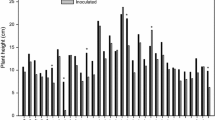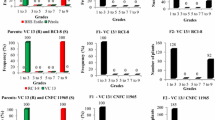Abstract
The level ofFusarium dry-rot resistance found in important potato varieties has been improved with agronomically acceptableSolanum tuberosum genotypes. Three breeding selections, A74114-4, A76260-16, and BR6316-7 were highly resistant to the two commonFusarium dry-rot species (F. roseum Lk ex Fr. f. sp.sambucinum [Fs], andF. solani var.coeruleum (Sacc), Booth [Fc]). Resistance was determined separately for each of these species. Resistance to Fs was genetically distinct from resistance to Fc since there was no correlation between Fs and Fc reaction for 180 progeny clones from six crosses representing all combinations of resistance. Resistance to each of theseFusarium species was readily transmitted to progeny. Seventy-five percent of the progeny from resistant X resistant parents were also resistant to Fs, while 95% of the progeny from susceptible X susceptible parents were susceptible. Mixed infections withErwinia atroseptica and eitherFusarium species resulted in a qualitative change from a resistant reaction to a susceptible reaction. Bacterial interaction withFusarium spp. is, therefore, an important consideration in determining storage-rot resistance.
Resumen
El nivel de resistencia a la pudrición seca porFusarium, econtrado en variedades importantes de papa, ha sido mejorado con genotipos agronomicamente aceptables deSolanum tuberosum. Tres selecciones de papa mejoradas, A74114-4, A76260-16, y BR6316-7 fueron altamente resistentes a las dos especies comunes deFusarium (F. roseum LK ex Fr. f. sp.sambucinum [Fs],y F. solani varcoeruleum (Sacc), Booth [Fc]. Se determinó, por separado, la resistencia para cada una de estas especies. La resistencia a Fs fue genéticamente distinta de la resistencia a Fc desde que no hubo correlación entre las reacciones a Fs y Fc de 180 clones de las progenies de seis cruzas que representaban todas las combinaciones de resistencia. La resistencia de cada una de las especies deFusarium fue transmitida fácilmente a las progenies. El 75% de la progenie de padres resistente X resistente fueron también resistentes a Fs, mientras que el 95% de la progenie de padres susceptible x susceptible fueron también susceptibles. Infecciones combinadas deErwinia atroseptica y cualquiera de las especies deFusarium, dieron por resultado un cambio cualitativo, pasando de una reacción resistente a una susceptible. Por lo tanto, la interacción resistente a una susceptible. Por lo tanto, la interacción bacteriana conFusarium spp., es una importante consideración para determinar la resistencia a la pudrición en el almacenamiento.
Similar content being viewed by others
Literature Cited
Ayers, G.W. 1956. The resistanceof potato varieties to storage decay caused byFusarium sambucinum F.G. andFusarium coeruleum. Am Potato J 33:249–254.
Boyd, A.E.W. 1952. Dry rot disease of the potato VI. varietal differences in tuber susceptibility obtained by injection and riddle-abrasion methods. Ann Appl Biol 39:339–350.
Boyd, A.E.W. 1972. Dry RotFusarium spp. in, ‘Potato Storage Diseases’. Rev Plant Pathol 51:305–311.
Corsini, D. and J.J. Pavek. 1980. Phenylalanine ammonia lyase activity and fungitoxic metabolites produced by potato cultivars in response toFusarium tuber rot. Physiol Plant Pathol 16:63–72.
Corsini, D. and J. Pavek. 1982. Dry rot resistance, Fusarium species, and temperature effects. Am Potato J 59:462 (abstr).
Davis, J.R., L.H. Sorensen and Gale S. Corsini. 1983. Interaction ofErwinia spp. andFusarium roseum ‘Sambucinum’ on the Russet Burbank potato. Am Potato J 60:409–421.
Dobias, Karel. 1976. Methoden zur prufung der resistenz vonkartoffeln gegenden erregerder knollennassfaule Tag. Ber Akad. Landwirtsch-Wiss 140:221–230.
Jellis, G.J. 1975. Screening potato clones for resistance to dry rot (Fusarium solani var.coeruleum). Ann Appl Biol 81:417–418.
Lapwood, D.H., P.J. Read and Janis Spokes. 1984. Methods for assessing the susceptibility of potato tubers of different cultivars to rotting byErwinia carotovora subspeciesatroseptica andcarotovora. Plant Pathol 33:13–20.
Leach, S.S. and R.K. Webb. 1981. Resistance of selected potato cultivars and clones toFusarium dry rot. Phytopathology 71:623–629.
O’Brien, Valerie J. and Simeon S. Leach. 1983. Investigations into the mode of resistance of potato tubers toFusarium roseum ‘Sambucinuml. Am Potato J 60:227–233.
Sorensen, Leland H. and Walter C. Sparks. 1980. A method for determining the bruise resistance of potatoes. Am Potato J 57:494 (abstr).
Author information
Authors and Affiliations
Additional information
Contribution from the Agricultural Research Service, U.S. Department of Agriculture in cooperation with the Idaho Agricultural Experiment Station. Idaho Agricultural Experiment Station Research Paper No. 8671.
Rights and permissions
About this article
Cite this article
Corsini, D., Pavek, J.J. Fusarium dry-rot resistant potato germplasm. American Potato Journal 63, 629–638 (1986). https://doi.org/10.1007/BF02852925
Accepted:
Issue Date:
DOI: https://doi.org/10.1007/BF02852925




